Discovering Labrang Monastery: A Must-Visit Destination for Culture Enthusiasts
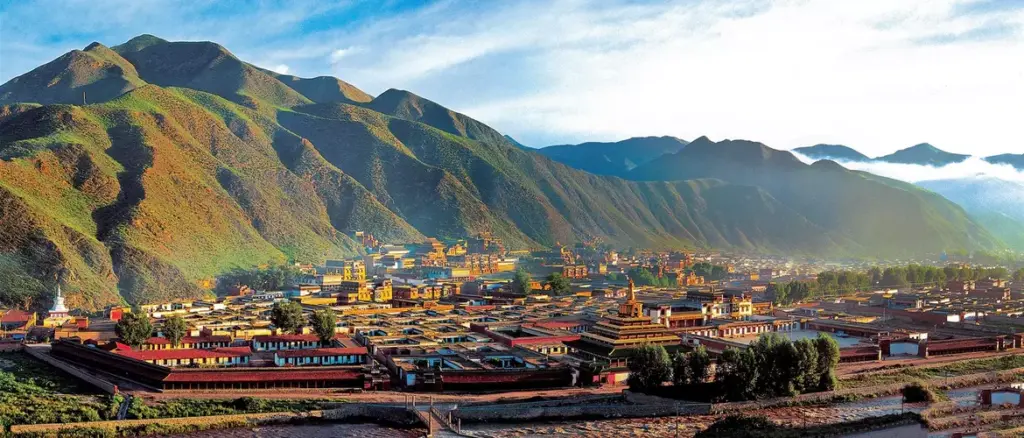
An Essential Guide to Visiting Labrang Monastery Complex
Nestled in the heart of Xiahe County, the Labrang Monastery Complex stands as a vibrant testament to Tibetan Buddhism and a cornerstone of Gelugpa (Yellow Hat) heritage. Founded in 1709, this sprawling monastery is one of the six great monasteries of the Geluk sect, housing over 2,000 monks and a treasure trove of spiritual and architectural wonders. Visitors to Labrang are often captivated by the intricate beauty of its eighteen halls, the towering golden stupa, and the vast collection of nearly 60,000 sutras that echo the wisdom of centuries gone by.
A visit to Labrang is not merely a sightseeing experience; it’s an immersion into a living, breathing community where age-old traditions blend seamlessly with the daily lives of its residents. As you wander through the complex, you’ll witness monks engaged in morning prayers, their resonant chants filling the air with a serene energy that invites reflection. The 3.5-kilometer kora, or circumambulation path, offers an opportunity to join local pilgrims in their spiritual practice, fostering a sense of connection and shared purpose.
Whether you’re seeking insights into Tibetan philosophy, marveling at exquisite yak butter sculptures, or simply taking in the breathtaking surroundings, Labrang Monastery Complex promises a journey that will enrich your understanding of this unique culture. Prepare to be enchanted by the sights, sounds, and spiritual essence of one of Tibet’s most revered monasteries.
In This Guide
- An Essential Guide to Visiting Labrang Monastery Complex
- The Rich History and Legends of Labrang Monastery Complex
- Main Highlights: What You Absolutely Can’t Miss
- Planning Your Visit: A Practical Guide
- Tickets: Prices, Booking, and Tips
- How to Get There: A Complete Transportation Guide
- Local Cuisine and Accommodation Nearby
- Frequently Asked Questions
- Final Thoughts on Your Trip
The Rich History and Legends of Labrang Monastery Complex
Nestled in the heart of Xiahe County, the Labrang Monastery Complex, also known as Labuleng Si, stands as a monumental testament to the rich tapestry of Tibetan Buddhism. Founded in 1709, this sanctuary is one of the six great monasteries of the Gelukpa (Yellow Hat) Sect, drawing countless pilgrims and travelers alike into its sacred embrace. With over 2,000 monks residing in its expansive grounds, Labrang is not merely a monastery; it is a bustling hub of spiritual learning and devotion.
The complex features eighteen magnificent halls, six institutes of learning, and a golden stupa, all housing nearly 60,000 sutras. Each structure echoes the profound philosophical teachings of Tibetan Buddhism while showcasing intricate architectural artistry that has withstood the test of time. The harmonious blend of vibrant murals, ornate sculptures, and serene prayer halls creates an atmosphere that is both contemplative and awe-inspiring.
One of the most captivating aspects of Labrang Monastery is its lively daily rituals. Visitors can witness the grand morning prayers, where up to 800 monks gather in a mesmerizing display of devotion, chanting sacred texts and invoking blessings. The rhythmic sound of their voices reverberates through the halls, creating an enchanting ambiance that lingers in the air.
Legends also abound within the walls of Labrang. Local folklore speaks of a revered monk who, during a period of drought, prayed fervently for rain. His unwavering faith was rewarded, and the skies opened up, restoring life to the parched land. This tale is just one of many that encapsulate the deep spiritual connection the monks and the local community share.
The monastery is also famous for its kora, a sacred circumambulation path that stretches approximately 3.5 kilometers around the complex. Pilgrims, both local and international, partake in this ritual, walking clockwise while reciting prayers. Following the kora not only offers a glimpse into the daily lives of the monks but also allows visitors to connect with the profound spirituality that permeates the area.
Over the years, Labrang Monastery has evolved, becoming a significant cultural and spiritual landmark. While it has attracted a growing number of tourists, this influx has also facilitated renovations and improvements to its facilities, preserving its historical and cultural significance for future generations. However, some visitors express a bittersweet sentiment regarding the transformation of the monastery into a bustling tourist destination, a reminder of the delicate balance between tradition and modernity.
In summary, the Labrang Monastery Complex is a place where history, spirituality, and legend intertwine. Its rich heritage and vibrant community invite travelers from around the world to explore its sacred grounds, offering an unforgettable glimpse into the essence of Tibetan Buddhism and the enduring legacy of its teachings. Whether you are seeking spiritual enlightenment or simply wish to immerse yourself in a unique cultural experience, Labrang is a destination that promises to leave an indelible mark on your journey.
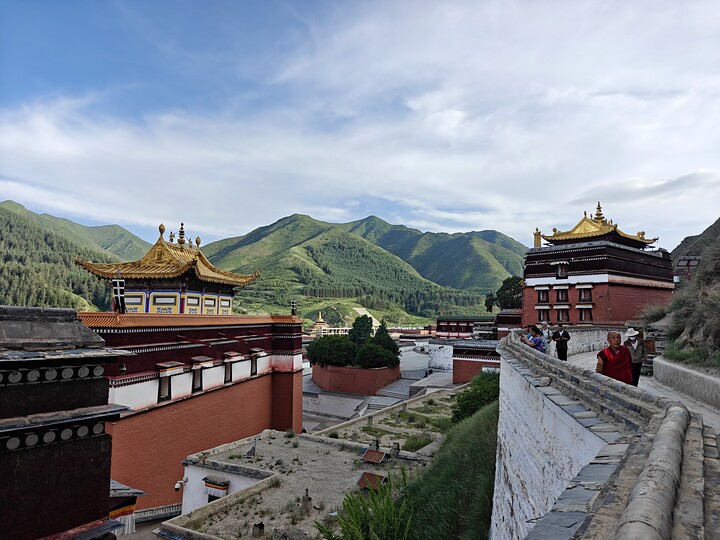
Labrang Monastery Complex.
Main Highlights: What You Absolutely Can’t Miss
The Labrang Monastery Complex is a mesmerizing blend of spiritual depth, architectural grandeur, and cultural richness that beckons travelers from around the globe. Here are the must-see highlights that will elevate your visit to this iconic site:
1. The Grand Prayer Hall
Step into the heart of Labrang Monastery at the Grand Prayer Hall, where the air is thick with the chanting of monks and the scent of incense. This impressive hall hosts up to 800 monks during morning prayers, creating a powerful atmosphere of devotion. Arrive early to witness this awe-inspiring ritual and immerse yourself in the spiritual energy that envelops the space.
2. The Kora Trail
For a unique perspective of the monastery and a chance to connect with local pilgrims, embark on the Kora—a sacred path that circles the complex. Stretching approximately 3.5 kilometers, this trail is not only a physical journey but also a spiritual one, allowing you to walk in the footsteps of worshippers who perform their daily rituals. Along the way, you’ll encounter colorful prayer flags and the rhythmic turning of prayer wheels, enhancing the experience.
3. Golden Stupa and Yak Butter Sculptures
One of the highlights of the complex is the Golden Stupa, a stunningly ornate structure that stands as a symbol of Tibetan Buddhism. Don’t miss the chance to see the yak butter sculptures inside the temples, which are intricate artworks made from yak butter and colored with natural dyes. These sculptures are surprisingly detailed and serve as a testament to the artistic traditions within Tibetan culture.
4. Monastic Education Halls
Labrang is home to six institutes of learning, making it a center for Buddhist scholarship. Explore these halls to gain insight into the Gelukpa (Yellow Hat) sect’s teachings and philosophy. If you’re fortunate, you might even catch a glimpse of monks engaged in study or debate, which can be both enlightening and fascinating to observe.
5. Guided Tours with Monks
To truly appreciate the depth of Labrang Monastery, consider joining a guided tour led by an English-speaking monk. These tours provide invaluable context about the monastery’s history, architecture, and the daily lives of the monks, enriching your understanding of this vibrant spiritual community.
6. Climbing for Panoramic Views
For breathtaking views of the monastery and its surrounding landscapes, hike up the nearby hills. The elevated vantage point offers stunning panoramic views that are perfect for photography and reflection. The tranquility of the hillside is a stark contrast to the bustling activity below, allowing you to appreciate the serenity of the site.
7. Engaging with Local Pilgrims
Observe and interact with local pilgrims as they visit Labrang. Their devotion and rituals can provide a deeper understanding of Tibetan Buddhism. Many visitors find that joining them in their practices enhances their connection to the site and fosters a sense of community.
8. Cultural Experiences and Local Cuisine
After exploring the monastery, treat yourself to some local Tibetan cuisine at nearby restaurants such as the Nirvana Restaurant & Bar or the Snow Mountain Cafe. Sample traditional dishes while mingling with locals and fellow travelers, making your visit to Labrang a well-rounded experience.
Visiting the Labrang Monastery Complex is not just a sightseeing trip; it’s an opportunity to delve into the rich tapestry of Tibetan culture, spirituality, and community. Each highlight offers a unique window into the life and practices of the monks, ensuring that your journey is both enlightening and unforgettable.

Labrang Monastery Complex.
Planning Your Visit: A Practical Guide
Visiting Labrang Monastery Complex is a unique and enriching experience that transports you into the heart of Tibetan Buddhism. Here’s everything you need to know for a smooth and enjoyable visit.
Getting There
Labrang Monastery is located in Xiahe County, Gansu Province, China. The most convenient way to reach the monastery is by bus from Lanzhou. Buses depart frequently from the Lanzhou South Bus Station, with departures typically at 7:30 AM, 8:30 AM, 9:30 AM, 2:00 PM, and 3:00 PM. The journey takes approximately 6 to 7 hours, so be prepared for a long ride. Tickets can be purchased at the terminal (cash only), and it’s advisable to arrive early to secure your spot.
Entrance Fee and Guided Tours
A nominal entrance fee of about 40 RMB grants you access to the monastery. For a more immersive experience, consider joining a guided tour, which is highly recommended. English-speaking monks often lead these tours, providing insights into the monastery’s rich history, architecture, and the Gelukpa (Yellow Hat) sect of Tibetan Buddhism. Tours typically begin around 10:15 AM, so plan your arrival accordingly to catch one.
Best Times to Visit
The monastery is open daily from 8:00 AM to 5:00 PM. Visiting early in the morning allows you to witness the enchanting morning prayers, where up to 800 monks chant in unison—a sight and sound that is both moving and memorable. The best time to experience the serenity of the monastery is during these prayer sessions, or later in the day when the crowds have thinned.
What to Expect
Labrang Monastery is one of the largest and most significant Tibetan Buddhist monasteries outside of Lhasa, housing over 2,000 monks. The complex features 18 halls, six institutes of learning, a stunning golden stupa, and an impressive collection of nearly 60,000 sutras. Be sure to walk the Kora, a 3.5 km trail that encircles the monastery, which is frequented by local pilgrims engaging in their daily spiritual practice.
Local Amenities
Within close proximity to the monastery, you’ll find several restaurants and cafes catering to a variety of tastes. Notable options include:
- Snow Mountain Cafe: Known for its vegetarian-friendly menu and cozy atmosphere.
- Nirvana Restaurant & Bar: Offers a mix of Chinese and Western dishes.
- Wuze Linka Restaurant: A great spot for traditional Tibetan cuisine.
Cultural Considerations
When visiting Labrang Monastery, it’s important to respect the local customs and traditions. Always dress modestly and refrain from taking photos in restricted areas, especially inside temples. If you wish to photograph the beautiful yak butter sculptures, you may do so, but be mindful of the monks and their practices.
Accommodation
For those looking to stay overnight, consider booking a room at the Shangu Guesthouse, located conveniently across from the White Stupa. This offers easy access to the monastery and a chance to immerse yourself in the tranquil surroundings.
Final Tips
- Bring Cash: Many local vendors and restaurants do not accept cards, so it’s wise to carry cash.
- Altitude Awareness: Xiahe is at a high altitude, so acclimatization may be necessary for some travelers. Stay hydrated and take it easy on your first day.
- Learn Basic Phrases: While many monks speak some English, learning a few basic Mandarin phrases can enhance your experience and interactions.
With its breathtaking architecture, profound spirituality, and welcoming community, Labrang Monastery Complex promises an unforgettable journey into Tibetan culture. Whether you’re there for the prayers, the architecture, or simply to soak in the atmosphere, your visit will surely leave a lasting impression.
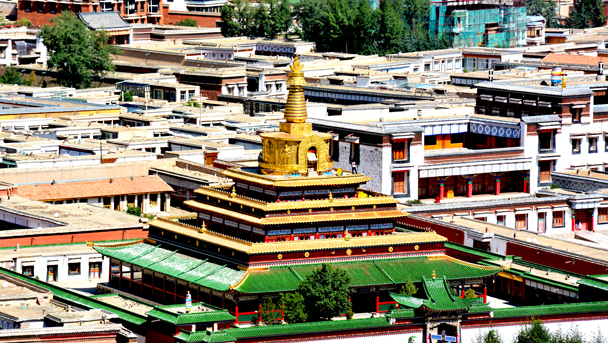
Labrang Monastery Complex.
Tickets: Prices, Booking, and Tips
When planning your visit to the Labrang Monastery Complex, it’s essential to know the ticketing details, pricing, and helpful tips to make the most of your experience.
Ticket Prices
Admission to the Labrang Monastery is reasonably priced, with tickets costing approximately 40 RMB (about 6 USD). This fee includes access to the main areas of the monastery, and visitors often find it worthwhile to hire an English-speaking monk as a guide for an enriching experience. Guided tours typically commence at 10:15 AM, allowing visitors to delve deeper into the monastery’s history and significance.
Booking Tickets
Tickets can usually be purchased on-site at the monastery entrance. However, during peak tourist seasons, it’s advisable to arrive early to secure your entry without long waits. Keep an eye out for signs directing you to the ticket office, which is conveniently located near the entrance.
Tips for Your Visit
-
Plan for the Weather: The monastery is situated at a high altitude, so dress in layers and be prepared for sudden changes in weather, especially if you plan to hike the kora (the circumambulation path around the monastery).
-
Respect the Monastic Environment: As a sacred site, maintain a respectful demeanor, especially during prayer sessions. Photography is generally restricted inside the temples, with exceptions for specific areas, such as the yak butter sculptures.
-
Engage with Local Culture: For a more immersive experience, join the local pilgrims in their kora, which is about 3.5 kilometers long. This path not only offers a beautiful view of the monastery but also a chance to connect with the spiritual practices of the Tibetan Buddhists.
-
Explore Nearby Amenities: After your visit, consider dining at one of the nearby restaurants, such as the Snow Mountain Café or Nirvana Restaurant & Bar, where you can enjoy a meal and reflect on your experiences.
-
Transportation Tips: If you’re traveling from Lanzhou, direct buses are available from the Lanzhou South Bus Station multiple times throughout the day. Plan your journey accordingly, as the ride can be long but offers scenic views of the Gansu Province.
By following these tips and being mindful of your surroundings, your visit to the Labrang Monastery Complex is sure to be a memorable and enlightening experience.
How to Get There: A Complete Transportation Guide
To reach the breathtaking Labrang Monastery Complex in Xiahe County, you’ll find that planning your transportation is essential for a smooth journey. Here’s a detailed guide to help you navigate the roads and get to this stunning historical site.
By Bus
From Lanzhou
The most common and affordable way to reach Labrang Monastery is by bus from Lanzhou, the capital of Gansu Province.
-
Departure Point: Head to the Lanzhou South Bus Station (also known as Lanzhou Nan Zhan). This station is well-connected and can be easily accessed via city buses or taxis.
-
Bus Schedule: Buses to Xiahe operate multiple times throughout the day, typically at 7:30 AM, 8:30 AM, 9:30 AM, 2:00 PM, and 3:00 PM. It’s advisable to arrive early to secure your ticket, especially during peak tourist seasons.
-
Duration: The journey takes approximately 5 to 6 hours, depending on traffic conditions. Be prepared for a scenic ride through the stunning landscapes of Gansu Province.
-
Cost: Tickets are inexpensive, usually around 70 RMB. Payment is typically cash-only, so ensure you have enough local currency.
From Other Locations
If you are coming from other cities or provinces, consider taking a train or bus to Lanzhou first and then transferring to the bus for Xiahe.
Arrival in Xiahe
Once you arrive at Xiahe, the bus station is conveniently located near the town center, making it easy to navigate your way to the monastery.
-
Local Transport: You can take a taxi or a local minibus to the monastery. Taxis are affordable, and it’s a short ride of about 10 minutes.
-
Walking: If you’re feeling adventurous, the monastery is also within walking distance from the bus station, allowing you to soak in the local atmosphere as you make your way there.
Tips for Visiting Labrang Monastery
-
Guided Tours: To fully appreciate the richness of Labrang Monastery, consider joining a guided tour. English-speaking monks offer insights into the monastery’s history and significance. You can purchase your ticket (around 40 RMB) and join the guided tour that departs at 10:15 AM daily.
-
Dress Code: As a place of worship, dress modestly. Comfortable shoes are recommended, especially if you plan to walk the kora (the sacred path) around the monastery.
-
Timing: The monastery is open from 8:00 AM to 5:00 PM. Early morning visits can be particularly rewarding, as you may witness the monks engaging in chants and prayers.
-
Cultural Respect: Remember to be respectful of the local customs and practices while visiting, as Labrang is not only a tourist attraction but also a functioning monastery.
By following this transportation guide, you’ll be well on your way to experiencing the spiritual and cultural richness of Labrang Monastery, one of the six great monasteries of the Gelukpa (Yellow Hat) Sect. Enjoy your journey and the serene beauty that awaits!
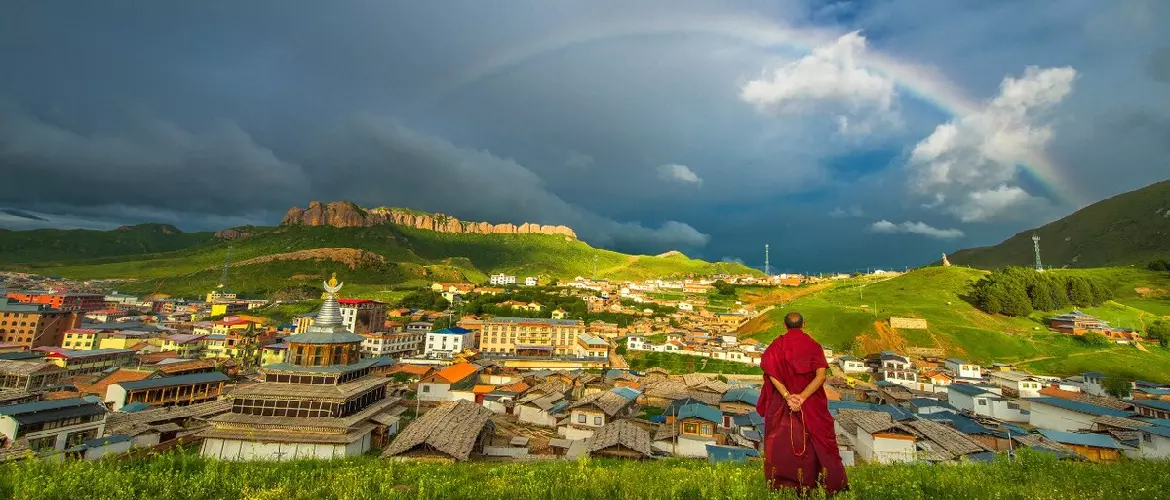
Labrang Monastery Complex.
Local Cuisine and Accommodation Nearby
If you find yourself exploring the serene surroundings of Labrang Monastery Complex in Xiahe County, you’re in for a treat—not only in terms of spiritual and cultural experiences but also when it comes to local cuisine and accommodation options.
Dining Options
After a day of wandering through the monastery and soaking in the rich traditions of Tibetan Buddhism, you’ll want to refuel. Here are some highly recommended dining spots nearby:
-
Nirvana Restaurant & Bar (0.5 miles away): Known for its vibrant atmosphere, this eatery offers a mix of Chinese dishes and bar snacks. It’s a great place to unwind after a long day of exploration, with vegetarian-friendly options available.
-
Snow Mountain Cafe (0.2 miles away): This cozy spot serves a variety of cuisines, including Indian and Italian. With a friendly vibe and a range of vegetarian-friendly options, it’s perfect for travelers looking to mix things up.
-
Wuze Linka Restaurant (1.8 miles away): For those craving authentic Tibetan flavors, this restaurant is a must-visit. It specializes in Asian and vegetarian dishes, making it a great choice for health-conscious diners.
-
AEr Bi Ka Café (0.7 miles away): Take a break at this quaint café, where you can enjoy a cup of coffee or tea while soaking in the local ambiance. It’s a lovely spot to relax and recharge.
-
Geng Sang Qu ZhenZang CanBa (0.6 miles away): This restaurant offers traditional Chinese and Asian dishes that reflect the local culinary culture. The warm atmosphere is ideal for a casual meal.
Accommodation
When it comes to finding a comfortable place to stay, you’ll find a range of options catering to various preferences and budgets:
-
Shangu Guesthouse: Located just across from the White Stupa, this guesthouse is a favorite among travelers. It provides a unique opportunity to immerse yourself in the local culture while enjoying modern amenities. Its proximity to the monastery makes it an excellent base for your explorations.
-
Xiahe Tibetan Culture Hotel: This charming hotel combines traditional Tibetan architecture with modern comforts. It offers cozy rooms and is conveniently located within walking distance of the monastery, making it easy to visit at any time of day.
-
Labrang Hotel: Just a short distance from the monastery, this hotel is an excellent choice for those seeking comfort and convenience. The friendly staff is always ready to assist, and the hotel features a restaurant serving local cuisine.
-
Tibetan Family Inn: Experience the warmth of Tibetan hospitality at this inn. The family-run atmosphere provides a unique and personal touch, and the home-cooked meals are a delightful highlight of your stay.
Exploring the Labrang Monastery Complex is sure to be a memorable experience, and with these dining and accommodation options nearby, you can enjoy the best of local culture and comfort as you embark on your Tibetan adventure.
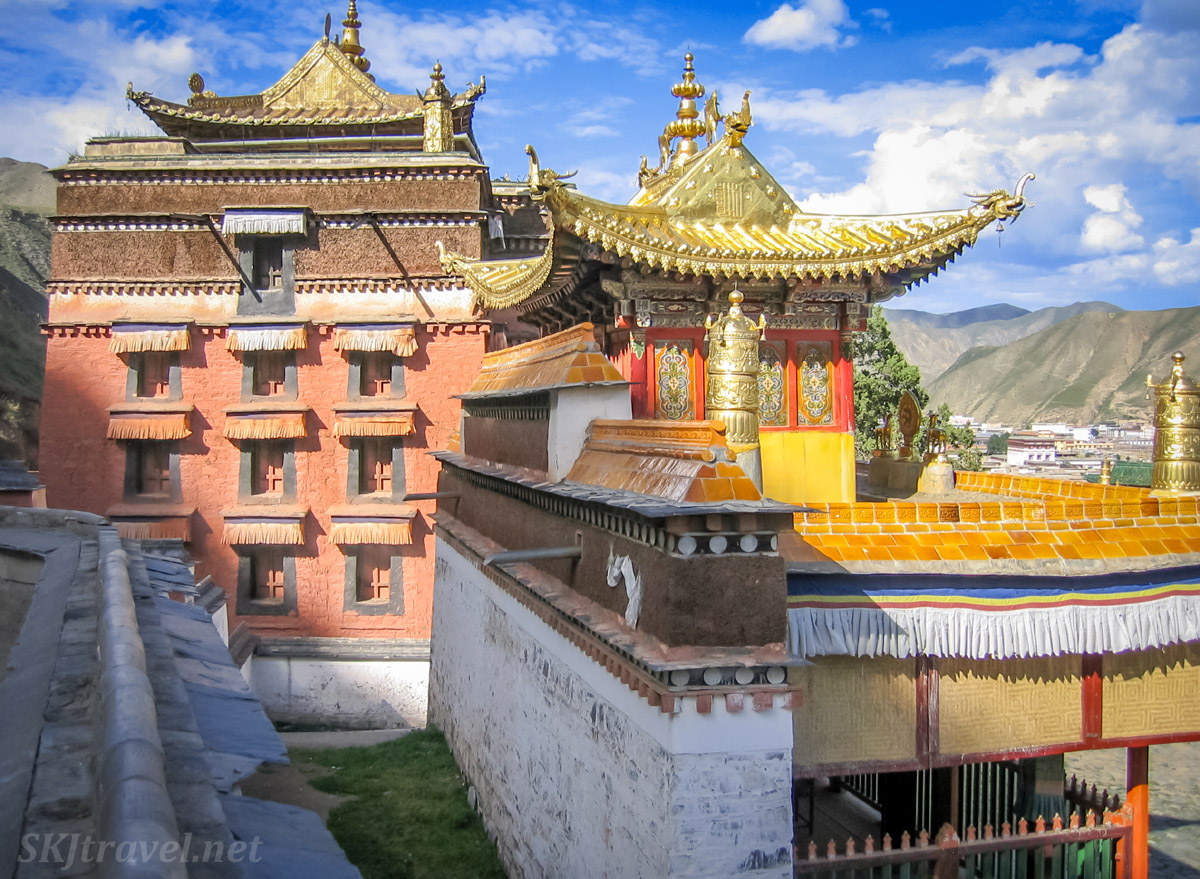
Labrang Monastery Complex.
Frequently Asked Questions
Frequently Asked Questions About Labrang Monastery Complex
-
What are the opening hours for Labrang Monastery?
Labrang Monastery is open daily from 8:00 AM to 5:00 PM. It’s best to visit during the morning hours to witness the monks during their morning prayers. -
How much is the entrance fee, and what does it include?
The entrance fee is 40 RMB, which includes access to the monastery grounds and a guided tour with an English-speaking monk. This guide can provide valuable insights into the monastery’s history and practices. -
How do I get to Labrang Monastery from Lanzhou?
You can take a direct bus from Lanzhou South Bus Station to Xiahe County, where the monastery is located. Buses typically leave at 7:30 AM, 8:30 AM, 9:30 AM, 2:00 PM, and 3:00 PM. The journey takes around 5 to 6 hours, so plan accordingly. -
Are there guided tours available?
Yes, guided tours are highly recommended to fully appreciate the site’s significance. You can join a guided tour led by an English-speaking monk that starts daily at 10:15 AM, but be sure to buy your tickets in advance. -
Can I take photographs inside the monastery?
Photography is generally not allowed inside the main prayer halls and temples to respect the sanctity of the space. However, you can take photos of the stunning yak butter sculptures and the exterior of the buildings. -
What should I wear when visiting the monastery?
Visitors are advised to dress modestly when visiting Labrang Monastery. This means covering your shoulders and knees out of respect for the local culture and religious practices. -
Is there a recommended route for exploring the monastery?
It’s highly recommended to walk the Kora, a 3.5 km trail that circles the monastery. This path is not only a spiritual exercise for pilgrims but also offers a unique perspective of the complex and the surrounding landscape. -
Are there dining options nearby?
Yes, there are several restaurants within walking distance of the monastery, offering a variety of cuisines. Popular choices include Snow Mountain Cafe and Nirvana Restaurant & Bar, where you can enjoy Tibetan and Chinese dishes.
Final Thoughts on Your Trip
As you conclude your journey through the Labrang Monastery Complex, take a moment to reflect on the unique blend of spirituality, culture, and history that this remarkable site offers. Nestled in the heart of Xiahe County, Labrang is not just a destination; it is a living testament to Tibetan Buddhism and the Gelukpa sect, where the rhythmic chants of monks and the serene presence of pilgrims create an ambiance that is both humbling and inspiring.
Walking the 3.5-kilometer kora, surrounded by vibrant prayer flags and the warm smiles of locals, you become part of a timeless ritual that has been practiced for centuries. The intricate architecture and the golden stupa stand as symbols of devotion and enlightenment, inviting you to explore deeper meanings of life and faith.
Whether you found yourself captivated by the grand prayer halls, mesmerized by the yak butter sculptures, or simply enchanted by the stunning views from the surrounding hills, Labrang has undoubtedly left an indelible mark on your heart. As you prepare to depart, carry with you the wisdom and tranquility that permeate this sacred space, and perhaps a newfound appreciation for the diverse tapestry of cultures and beliefs that enrich our world.
May your travels continue to inspire you, and may you always find beauty in the journey ahead. Safe travels!